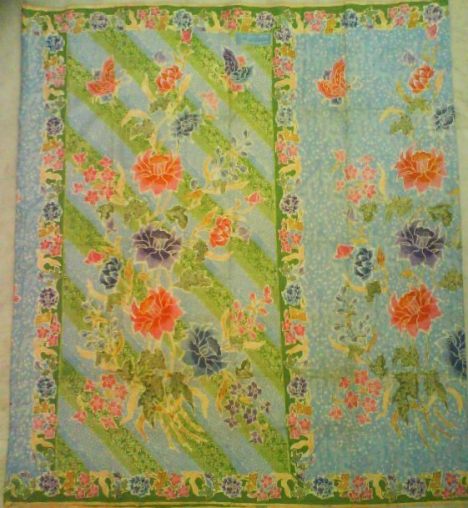
Material: Cotton
Colour: Synthetic dyes
Origin: Pekalongan, Java, Indonesia
Dimensions: 190 X 310 cm
Signed: Go Tjoe San, Pekalongan

The sarung (or sarong) here adheres to the styles of having two main parts, namely the badan (body) and kepala (head) of a typical sarung piece. The badan naturally covers most of the area of the sarong, and typically slightly less ornate as the designs on the kepala. Here, bouquets of flowers of different shades (red, pink, purple and blue) are found on both the kepala and badan. A pair of fluttering butterflies hover near the tops of the blooms, as if about to sip the nectar from the colourful flowers. The kepala here shows the same principal motifs as the badan except that the background looks more dense because it has parallel lines of arabesques and tiny dots moving downwards to the right, and a stamp depicting the Chinese name of Go Tjoe San (most likely of the batik workshop, or maker, or even trader). The batik here, with its main principal motifs repeated throughout the cloth suggests it is batik cap, or stamped batik.

This batik has features which were common in batik made for the Peranakan womens’ market. A first hint is the choice of colour schemes for the fabric, which is bright not sombre, and rather colourful, reminiscent of the colourful, old Chinese enamelled porcelain called Nyonyaware which is synonymous with the Peranakans. The sign of the maker, a Chinese name also accentuates the notion that this cloth was meant mainly for the Chinese Peranakan market. A signed batik usually comes with the better pieces, and when given as gifts, are a symbol of a valuable gift. The motifs of the butterflies, while not restricted to traditional Chinese symbolism, are a common motif which carries the meaning of happiness. A paired butterfly also connotes fidelity and happiness among couples.
Pekalongan, a city on the Northern Coast of Java, is famous for batik-making till today. Batik made in the region has a distinctive style and can usually be identified as a Pekalongan styled batik. Pekalongan batik was famous among the Straits Chinese and Peranakans in Malaya and Singapore. The community loved the vibrant and almost festive colours of batik from the towns of Pekalongan and nearby Kedungwuni. With the advent of synthethic dyes, the choices of colours for batik increased dramatically, and colours once impossible or hard to attain were now within reach of the batik makers who capitalized on their customers’ tastes for these bright and flamboyant colours.
As the piece was reputedly collected from the Riau Islands, a Peranakan lady of the region was probably the original owner of the piece who might have worned it for outings.
Filed under: Batik Review | Tagged: batik, batik cap, batik signature, go tjoe san, pekalongan, peranakan, riau, sarong, signed batik | 3 Comments »


